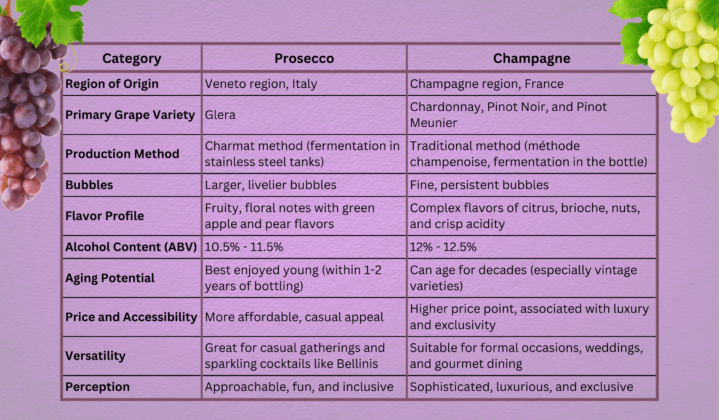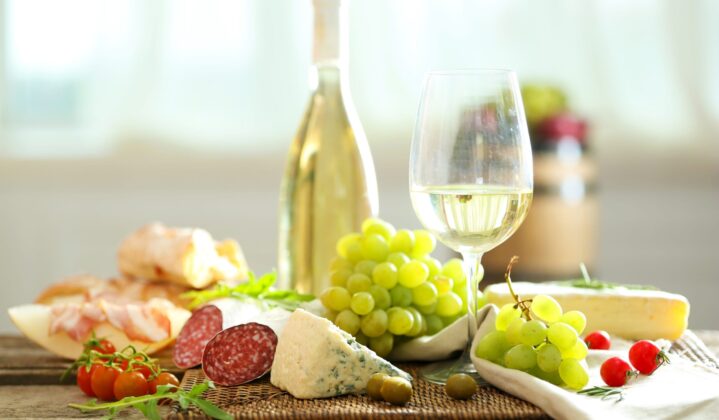Prosecco vs Champagne: What is the difference?
Sparkling wines have long been symbols of celebration, elegance, and indulgence. Among the most famous are Champagne and Prosecco, two beloved sparkling wines that each bring a unique character to the table. While both are known for their effervescence and ability to elevate any occasion, their differences extend far beyond the bubbles. Champagne, a “wine of place,” is exclusively produced in the Champagne region of France, a status that emphasizes its unparalleled heritage and craftsmanship. Meanwhile, Prosecco originates in Italy’s Veneto region, celebrated for its vibrant, fruity nature and accessible appeal.
Understanding these distinctions, from their regional identities to the methods behind their creation, can help you choose the perfect bottle for any occasion. Whether it’s a milestone celebration or a casual toast, knowing what sets Prosecco and Champagne apart ensures an experience as sparkling as the wine itself.
Explore the key differences that make each wine truly one of a kind.
1. Grape Varieties: The Foundation of Flavors of Champagne and Prosecco
The grapes used in each sparkling wine further highlight their individuality. Champagne relies on a blend of Chardonnay, Pinot Noir, and Pinot Meunier grapes. These varieties contribute to its complexity, offering notes of citrus, brioche, and nuts. The balance between these grapes is key to Champagne’s elegance.
Prosecco is primarily made from Glera grapes, which lend a lighter, fruitier profile. Expect flavors of green apple, pear, and floral notes, making Prosecco refreshing and approachable. The choice of grapes directly affects the taste and versatility of these sparkling wines, catering to different palates and occasions.
2. Production Method: Tradition vs. Modernity
The methods used to produce Champagne and Prosecco are not just different—they’re defining. Champagne employs the traditional method, known as méthode champenoise, which involves a labor-intensive process. The wine undergoes a secondary fermentation inside the bottle, where yeast and sugars interact to create its fine bubbles. This method, along with extended aging, imparts complexity, depth, and the signature creamy texture associated with Champagne.
Prosecco, in contrast, uses the Charmat method. Here, the fermentation happens in large stainless-steel tanks, allowing for the creation of bubbles on a larger scale before bottling under pressure. This approach is quicker, more efficient, and less expensive than the traditional method. While the Charmat method results in a sparkling wine with larger and more playful bubbles, it also preserves the fresh, fruity notes that Prosecco is known for. The efficiency of this method is one reason Prosecco is more accessible and budget-friendly than Champagne.
3. Difference in Carbonation and Bubbles
The production methods for Champagne and Prosecco directly influence their bubbles. In Champagne, the secondary fermentation within the bottle ensures fine, persistent bubbles that give the wine its luxurious texture. These delicate bubbles add to Champagne’s reputation for refinement and elegance.
Prosecco’s Charmat method, on the other hand, yields a livelier effervescence with larger bubbles. Fermenting the wine in tanks instead of individual bottles helps maintain its bright and fruity character while keeping production costs lower. This difference in carbonation also affects texture—Champagne feels creamy and smooth, while Prosecco is light, crisp, and vibrant, making it a great choice for casual sipping or as a base for sparkling cocktails.
4. Notes and Flavor Profiles
When it comes to flavor, Champagne and Prosecco couldn’t be more different. Champagne is celebrated for its complexity, often boasting notes of toasted bread, nuts, and citrus with a crisp acidity. Its layered flavors make it a versatile choice for pairing with gourmet dishes, from oysters to creamy cheeses.
Prosecco, on the other hand, is light, fruity, and floral. Its sweetness level varies, with options ranging from Brut to Extra Dry, but it generally leans toward a sweeter, more approachable taste. Prosecco’s straightforward flavor makes it a favorite for casual gatherings and simple food pairings like antipasto or fresh fruits.
5. Subtle Differences in Alcohol Content
The alcohol content in Prosecco and Champagne also varies slightly. Champagne typically has an alcohol by volume (ABV) of around 12% to 12.5%, giving it a balanced kick without being overpowering.
Prosecco tends to have a slightly lower ABV, averaging between 10.5% and 11.5%. This lower alcohol content makes Prosecco an appealing choice for daytime events or those who prefer lighter beverages. While the difference may be small, it’s worth considering when planning your drink menu.
6. Aging Potential: Drink Now or Save for Later?
Champagne is renowned for its aging potential, particularly vintage varieties. Properly stored bottles can mature for decades, with aging enhancing their complexity and depth. This ability to age well adds to Champagne’s allure and exclusivity.
Prosecco, by comparison, is best enjoyed young. Its fresh, fruity flavors are at their peak within a year or two of bottling. Unlike Champagne, Prosecco’s charm lies in its immediacy, offering an easy-drinking experience without the need for long-term storage.
7. Versatility and Usage
Champagne’s reputation as a luxury item makes it a staple at formal events, weddings, and celebrations. Its elegance and complexity also make it suitable for high-end dining and toasting on special occasions. Champagne often feels like a statement piece, elevating the moment.
Prosecco, however, is the life of the party. Its affordability and lighthearted character make it perfect for casual occasions, picnics, and social gatherings. Prosecco is also incredibly versatile in cocktails, bringing a sparkling twist to drinks like spritzers and Bellinis.
8. Branding and Perception
 The final key difference lies in how these sparkling wines are perceived. Champagne, with its strict regulations and centuries-old traditions, is often seen as a symbol of luxury and sophistication. Its branding emphasizes exclusivity, quality, and heritage.
The final key difference lies in how these sparkling wines are perceived. Champagne, with its strict regulations and centuries-old traditions, is often seen as a symbol of luxury and sophistication. Its branding emphasizes exclusivity, quality, and heritage.
Prosecco, on the other hand, is celebrated for its approachability. Its branding reflects fun, affordability, and inclusivity, appealing to a broader audience. Both wines have carved out their niche, allowing consumers to choose based on occasion, mood, and personal preference.
Choosing the Right Sparkling Wine: Prosecco vs Champagne?

Prosecco and Champagne each bring something special to the table. Champagne offers complexity, elegance, and tradition, making it the ideal choice for formal occasions and refined tastes. Prosecco, with its fruity charm and affordability, shines at casual gatherings and as a versatile cocktail ingredient.
Whether you’re raising a toast to a milestone or simply enjoying a sparkling treat, both wines have their place in your celebrations. By understanding their differences, you can select the perfect bottle to suit your occasion and personal style.
